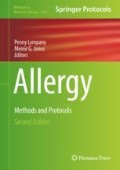Abstract
Common methods to quantify molds in the environment are based on the detection of viable and nonviable fungal components using cultivation technique or assessment by microscopy. These methods are time consuming and laborious and require a high expertise and especially in airborne exposure studies they showed poor reproducibility. Therefore alternative techniques based on molecular or immunological tools attract wide interest. The development of specific ELISAs based on polyclonal antibodies to detect mold antigens in airborne samples starting with the extraction of the antigen material up to evaluation of the sandwich ELISA is summarized in this chapter.
Access this chapter
Tax calculation will be finalised at checkout
Purchases are for personal use only
References
Eduard W, Heederik D, Duchaine C et al (2012) Bioaerosol exposure assessment in the workplace: the past, present and recent advances. J Environ Monit 14:334–339
Crowther JR (2009) The ELISA guidebook. Humana Press, New York, NY
Lipman NS, Jackson LR, Trudel LJ et al (2005) Monoclonal versus polyclonal antibodies: distinguishing characteristics, applications, and information resources. ILAR J 46:258–268
Chapman MD, Vailes LD, Ichikawa K (2000) Immunoassays for indoor allergens. Clin Rev Allergy Immunol 18:285–300
Raulf M, Buters J, Chapman M et al (2014) Monitoring of occupational and environmental aeroallergens - EAACI position paper: concerted action of the EAACI IG occupational allergy and aerobiology & air pollution. Allergy 69:1280–1299
Ryan TJ, Whitehead LW, Connor TH et al (2001) Survey of the Asp f 1 allergen in office environments. Appl Occup Environ Hyg 16:679–684
Vailes L, Sridhara S, Cromwell O et al (2001) Quantitation of the major fungal allergens, Alt a 1 and Asp f 1, in commercial allergenic products. J Allergy Clin Immunol 107:641–646
Sander I, Zahradnik E, van Kampen V et al (2012) Development and application of mold antigen-specific enzyme-linked immunosorbent assays (ELISA) to quantify airborne antigen exposure. J Toxicol Environ Health Part A 75:1185–1193
Zahradnik E, Kespohl S, Sander I et al (2013) A new immunoassay to quantify fungal antigens from the indoor mould Aspergillus versicolor. Environ Sci Process Impacts 15:1162–1171
van Kampen V, Sander I, Liebers V et al (2014) Concentration of bioaerosols in composting plants using different quantification methods. Ann Occup Hyg 58:693–706
Leenaars M, Hendriksen CFM (2005) Critical steps in the production of polyclonal and monoclonal antibodies: evaluation and recommendations. ILAR J 46:269–279
Stills HF (2005) Adjuvants and antibody production: dispelling the myths associated with Freund’s complete and other adjuvants. ILAR J 46:280–293
Author information
Authors and Affiliations
Corresponding author
Editor information
Editors and Affiliations
Rights and permissions
Copyright information
© 2019 Springer Science+Business Media, LLC, part of Springer Nature
About this protocol
Cite this protocol
Zahradnik, E., Raulf, M. (2019). Development of Mold Antigen-Specific Enzyme-Linked Immunosorbent Assays (ELISA) to Quantify Airborne Antigen Exposure. In: Lympany, P., Jones, M. (eds) Allergy. Methods in Molecular Biology, vol 2020. Humana, New York, NY. https://doi.org/10.1007/978-1-4939-9591-2_8
Download citation
DOI: https://doi.org/10.1007/978-1-4939-9591-2_8
Published:
Publisher Name: Humana, New York, NY
Print ISBN: 978-1-4939-9589-9
Online ISBN: 978-1-4939-9591-2
eBook Packages: Springer Protocols

